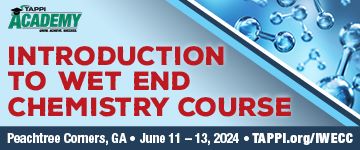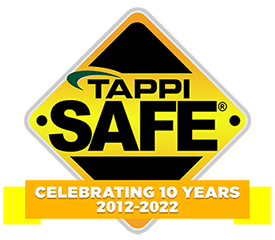 Search
Search
Use the search bar or filters below to find any TAPPI product or publication.
Filters
Content Type
Publications
Level of Knowledge
Collections
Journal articles

Magazine articles

Fiber-based characterization of pulp refining, TAPPI Journal September 2022
ABSTRACT: Fiber development in pulp refining can be characterized by three parameters: number of impacts on pulp, N; energy per impact, I, and bar force on fibers, F. These parameters enable comparisons of radically different refining conditions; determination of intensity for hardwoods and softwoods; assessment of effect of bar width on fiber shortening; and predictions of tensile strength increases.
Journal articles

Magazine articles

Commercially relevant water vapor barrier properties of high amylose starch acetates: Fact or fiction?, TAPPI Journal September 2021
ABSTRACT: Starches have recently regained attention as ecofriendly barrier materials due to the increased demand for sustainable packaging. They are easily processable by conventional plastics processing equipment and have been utilized for oil and grease barrier applications. While starches have excellent oxygen barrier properties and decent water barrier properties at low relative humidity (RH), they are moisture sensitive, as demonstrated by the deterioration of the barrier properties at higher RH values. Starch esters are chemically modified starches where the hydroxyl group of the starch has been substituted by other moieties such as acetates. This imparts hydrophobicity to starches and has been claimed as a good way of retaining water vapor barrier properties of starches, even at high RH conditions. We studied the water vapor barrier properties of one class of starch esters, i.e., high amylose starch acetates that were assumed to have good water vapor barrier properties. Our investigations found that with a high degree of substitution of hydroxyl groups, the modified starches did indeed show improvements in water vapor response as compared to pure high amylose starch films; however, the barrier properties were orders of magnitude lower than commercially used water vapor barriers like polyethylene. Even though these materials had improved water vapor barrier response, high amylose starch acetates are likely unsuitable as water vapor barriers by themselves, as implied by previous literature studies and patents.
Journal articles

Magazine articles

Boiler retrofit improves efficiency and increases biomass firing rates, TAPPI Journal March 2021
ABSTRACT: Domtar’s fluff pulp mill in Plymouth, NC, USA, operates two biomass/hog fuel fired boilers (HFBs). For energy consolidation and reliability improvement, Domtar wanted to decommission the No. 1 HFB and refurbish/retrofit the No. 2 HFB. The No. 2 HFB was designed to burn pulverized coal and/or biomass on a traveling grate. The steaming capacity was 500,000 lb/h from coal and 400,000 lb/h from biomass. However, it had never sustained this design biomass steaming rate. As the sole power boiler, the No. 2 HFB would need to sustain 400,000 lb/h of biomass steam during peak loads. An extensive evaluation by a combustion and boiler technologies supplier was undertaken. The evaluation involved field testing, analysis, and computational fluid dynamics (CFD) modeling, and it identified several bottle-necks and deficiencies to achieving the No. 2 HFB’s biomass steam goal. These bottlenecks included an inadequate combustion system; insufficient heat capture; excessive combustion air temperature; inadequate sweetwater con-denser (SWC) capacity; and limited induced draft fan capacity.To address the identified deficiencies, various upgrades were engineered and implemented. These upgrades included modern pneumatic fuel distributors; a modern sidewall, interlaced overfire air (OFA) system; a new, larger economizer; modified feedwater piping to increase SWC capacity; replacement of the scrubber with a dry electrostatic precipitator; and upgraded boiler controls.With the deployment of these upgrades, the No. 2 HFB achieved the targeted biomass steaming rate of 400,000 lb/h, along with lowered stack gas and combustion air temperatures. All mandated emissions limit tests at 500,000 lb/h of steam with 400,000 lb/h of biomass steam were passed, and Domtar reports a 10% reduction in fuel firing rates, which represents significant fuel savings. In addition, the mill was able to decommission the No. 1 HFB, which has substantially lowered operating and maintenance costs.
Journal articles

Magazine articles

Peracetate/singlet oxygen chemistry used in post-bleaching of kraft pulp as a practical oxidant for paper machines, TAPPI Journal May 2021
ABSTRACT: The use of a novel sodium peracetate/singlet oxygen chemistry for brightening bleached kraft pulp shows exciting potential for technical performance, supply logistics, safety, and cost reduction. Potential chemical carryover to the paper machine raises questions about whether peracetate will impact paper machine performance, such as metal corrosion, useful press felt life, and interference with existing biocide programs or paper machine chemistry. Sodium peracetate/singlet oxygen chemistry can be used in high-density storage chests for brightening/whitening and to increase color stability. Any oxidant used directly before the paper machine has the possibility of impacting paper machine operations. Traditional oxidants used in bleaching, such as chlorine dioxide and hydrogen peroxide, are known to cause corrosion on machinery metals and press felts. Hydrogen peroxide residuals can interfere with common biocide programs. Traditional oxidants used in biocide treatments themselves significantly degrade press felt life when the rule-of-thumb concentration thresholds are exceeded. Sodium peracetate is evaluated in this paper for its impact on nylon press felt fiber degradation, metal corrosion, and interference with typical biocide programs.Laboratory results indicate that sodium peracetate/singlet oxygen chemistry is less corrosive than chlorine, bromine, and hydrogen peroxide on press felt nylon fiber and can therefore be used at higher levels than those chemistries to increase brightness without increasing negative downstream impact. Sodium peracetate can also be used with current biocide programs without negative impacts such as consumptive degradation. Higher residuals of peracetate going to the paper machine may be useful as a biocide itself and can complement existing programs, allowing those programs to stay within their safe operating levels and thereby extend press felt useful life.
Journal articles

Magazine articles

Mechanical modification of softwood pulp fibers using a novel lightweight vertical bar plate, TAPPI Journal April 2021
ABSTRACT: Refiner plates made using sand casting have a draft angle, which results in a trapezoidal bar shape. These trapezoidal bar plates have a limited throughput compared to the vertical bar plates, and eventually the edges of the bars become dull, resulting in longer time to reach the target freeness and shorter service life. The new light-weight refiner plate with a bar insertion method into a plate base was developed by selecting an aluminium-based alloy as the plate base material and a stainless steel alloy with high wear resistance as the bar material. The light-weight plate with sharp bar edges was very effective in reducing refining energy by reaching the target freeness faster than the sand-cast bar plate. Finally, the lightweight sharp bar plate, which weighed only about half the weight of the cast bar plate, was expected to significantly contribute to easy replacement, improved paper quality, and larger throughput without excessive loss of fiber length.
Magazine articles

An overview of the south african pulp and paper industry, TAPPI JOURNAL, April 1999, Vol. 82(4)
An overview of the south african pulp and paper industry, TAPPI JOURNAL, April 1999, Vol. 82(4)
Magazine articles

Retention aids for highspeed paper machines, TAPPI JOURNAL, April 1999, Vol. 82(4)
Retention aids for highspeed paper machines, TAPPI JOURNAL, April 1999, Vol. 82(4)
Journal articles

Magazine articles

Life cycle carbon analysis of packaging products containing purposely grown nonwood fibers: A case study on the use of switchgrass pulp for linerboard and corrugating medium, TAPPI Journal March 2024
ABSTRACT: Sustainability is driving innovation in the pulp and paper industry to produce goods with lower carbon footprints. Although most of the efforts are currently focused on increasing energy efficiency or switching to renewable fuels, the attention toward alternative feedstocks has increased in recent years. Claims of nonwood fibers requiring lower use of chemicals and energy than wood fibers, along with negative consumer perceptions of tree felling, are helping purposely grown nonwoods to gain market share. The potential nonwood fiber environmental superiority over virgin or recycled wood fibers remains controversial and is often driven more by emotion and public perception rather than facts. This paper estimates the carbon footprint of corrugating medium and linerboard containing switchgrass pulp compared to analogous wood-based materials. The study includes a life cycle carbon analysis spanning from cradle to gate, which comprises stages for fiber production, pulping, papermaking, and corresponding transportation. Carbon footprints for virgin linerboard, recycled linerboard, virgin medium, and recycled medium were estimated at around 510, 620, 460, and 670 kg carbon dioxide equivalent per metric ton (kg CO2eq/t), respectively. Replacing 30% of the virgin or recycled material with switchgrass pulp translated into carbon footprint increases of around 60%, 45%, 62%, and 38%, respectively. Thus, for the proposed case study, the results suggest that switchgrass-based medium and linerboard can present a higher carbon footprint than products made from virgin and recycled wood fibers. The main driver is the production of nonwood mechanical pulp.This study was designed to mitigate part of the uncertainty around the environmental sustainability of medium and linerboard made from the selected purposely grown nonwood fibers.
Journal articles

Magazine articles

Life cycle carbon analysis of packaging products containing nonwood residues: A case study on linerboard and corrugating medium, TAPPI Journal March 2024
ABSTRACT: Circularity is creating momentum toward utilizing waste feedstock in a myriad of applications. The paper industry is not an exception to this trend, and packaging products made from agricultural or agro-industrial residues are receiving more attention now than ever. Additionally, negative consumer perceptions of tree felling are accelerating the acceptance of these fibers. Nevertheless, adopting these residues raises the issue of whether they constitute a better alternative to fight climate change than wood. Answering this question is imperative to ensure that pledges to reduce carbon footprints across the industry are fulfilled. This paper aims to estimate the carbon footprint of corrugating medium and linerboard containing wheat straw and sugarcane bagasse pulp compared to analogous wood-based materials. The goal was also to understand how methodological decisions to allocate emissions to nonwood residues can affect the results. This study includes a life cycle carbon analysis spanning from cradle to grave, which comprises stages for residue production, pulping, paper-making, waste management, and corresponding transportation. For the proposed case study, the results suggest that straw- and bagasse-based medium and linerboard can present a higher carbon footprint than products made from virgin and recycled wood fibers. The main driver is the production of nonwood chemimechanical pulp. In addition, the lower capacity of nonwood residues to be recycled increases the overall impact. Finally, decisions around emissions allocation highly influence the results. This study helps mitigate part of the uncertainty around the environmental sustainability of corrugating medium and linerboard made from the selected nonwood residues.
Journal articles

Magazine articles

Quantification of hardwood black liquor contamination in pine black liquor, TAPPI Journal February 2024
ABSTRACT: The presence of hardwood black liquor contamination in pine black liquor can negatively impact brownstock washer and evaporator operation, as well as reduce soap separation and yield. It is also believed to negatively impact commercial kraft lignin production. It was desired to develop a method of quantitatively determining the amount of low-level hardwood liquor contamination in pine black liquor. A method employing pyrolysis-gas chromatography mass spectrometry (py-GCMS) was developed to perform the desired measurement. Laboratory cooks with carefully controlled blends of pine and hardwood chips were prepared, and the resulting liquor was measured using this technique. Additionally, samples of pine and hardwood black liquors were blended in known quantities and analyzed. All these samples were submitted as blind samples. The resulting analysis suggests the py-GCMS method was able to accurately determine the level of hardwood contamination between 1% to 10% hardwood liquor using a low-level calibration curve prepared with coniferyl alcohol and sinapyl alcohol as standards.






